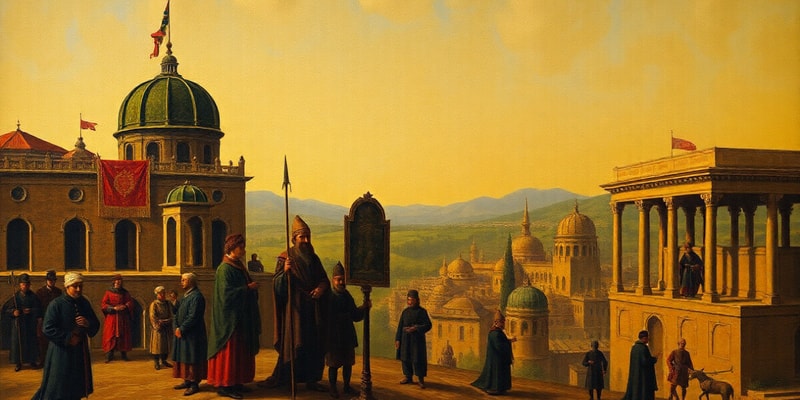Podcast
Questions and Answers
What two types of power did Shah Abbas use to strengthen the Safavid Empire?
What two types of power did Shah Abbas use to strengthen the Safavid Empire?
He used hard power and soft power.
How did Shah Abbas demonstrate soft power in his rule?
How did Shah Abbas demonstrate soft power in his rule?
He fostered trade relations with European nations and promoted Persian culture.
What was the foundation of the Safavid Empire's identity?
What was the foundation of the Safavid Empire's identity?
The Safavid Empire was founded on Shi'a Islam.
What was a key characteristic that distinguished the Safavid Empire from the Ottoman Empire?
What was a key characteristic that distinguished the Safavid Empire from the Ottoman Empire?
Signup and view all the answers
What is cultural blending in the context of the Safavid Empire?
What is cultural blending in the context of the Safavid Empire?
Signup and view all the answers
During which ruler's reign did the Safavid Empire experience its Golden Age?
During which ruler's reign did the Safavid Empire experience its Golden Age?
Signup and view all the answers
What factors contributed to the fall of the Safavid Empire?
What factors contributed to the fall of the Safavid Empire?
Signup and view all the answers
What military reforms did Shah Abbas implement in the Safavid Empire?
What military reforms did Shah Abbas implement in the Safavid Empire?
Signup and view all the answers
What were the main reasons for the decline of the Safavid Empire after Shah Abbas?
What were the main reasons for the decline of the Safavid Empire after Shah Abbas?
Signup and view all the answers
How did Akbar the Great use soft power to maintain the Mughal Empire?
How did Akbar the Great use soft power to maintain the Mughal Empire?
Signup and view all the answers
In what ways did Babur establish the Mughal Empire?
In what ways did Babur establish the Mughal Empire?
Signup and view all the answers
Which emperor is known for building the Taj Mahal and what does it symbolize?
Which emperor is known for building the Taj Mahal and what does it symbolize?
Signup and view all the answers
What internal policies did Akbar the Great implement to enhance cultural integration?
What internal policies did Akbar the Great implement to enhance cultural integration?
Signup and view all the answers
What characterized Aurangzeb's rule and its effects on the Mughal Empire?
What characterized Aurangzeb's rule and its effects on the Mughal Empire?
Signup and view all the answers
What role did European colonization play in the fall of the Mughal Empire?
What role did European colonization play in the fall of the Mughal Empire?
Signup and view all the answers
Describe the religious demographics of the Mughal Empire.
Describe the religious demographics of the Mughal Empire.
Signup and view all the answers
What is the significance of soft power in Akbar's governance?
What is the significance of soft power in Akbar's governance?
Signup and view all the answers
What marked the high point of the Mughal Empire during Akbar's reign?
What marked the high point of the Mughal Empire during Akbar's reign?
Signup and view all the answers
Study Notes
Safavid Empire
- Shah Abbas: A significant Safavid ruler known for modernizing the military and promoting arts. His reign marked the empire's Golden Age.
- Hard Power: Influence achieved through military force and economic coercion. Shah Abbas used this to strengthen the Safavid military and consolidate control.
- Soft Power: Influence achieved through persuasion, culture, and diplomacy. Shah Abbas employed this by fostering trade, promoting Persian culture, and using diplomacy.
- Shi'a Islam: The Safavid Empire's foundation, creating a distinct religious and political identity. This often led to conflicts with neighboring Sunni empires, particularly the Ottoman Empire.
- Cultural Blending: Integration of Persian, Turkish, and Islamic elements in art and architecture. This was evident in the architecture of Isfahan.
- Golden Age: A period of cultural and artistic achievement under Shah Abbas.
- Fall of Safavid Empire: Decline attributed to weak leadership and external pressures (Ottomans and Russians), internal instability, and succession disputes.
Mughal Empire
- Babur: Founder of the Mughal Empire, a descendant of Genghis Khan and Timur. He established the empire following the Battle of Panipat.
- Akbar the Great: A notable Mughal emperor known for religious tolerance and administrative reforms. He expanded the empire, centralized governance, promoted religious tolerance, and encouraged cultural integration. His reign often considered the high point of the empire.
- Shah Jahan: Mughal emperor famous for the Taj Mahal, a monumental architectural symbol of love. His reign marked the empire's peak in cultural and architectural achievement.
- Aurangzeb: The last major Mughal emperor remembered for religious conservatism. His expansionist policies worsened conflicts and internal struggles, marking a turning point toward decline.
- Hard Power: Influence achieved through military force and economic coercion. Mughal emperors used this extensively for empire expansion and governance.
- Soft Power: Influence achieved through persuasion, culture, and diplomacy. Akbar promoted religious tolerance and integration as key soft power strategies.
- Sunni Islam: The prevalent religion in the Mughal Empire, though rulers like Akbar promoted religious tolerance, incorporating Hindus and Sikhs.
- Religious Demographics: The Mughal Empire had a religiously diverse population including Muslims, Hindus, and other religious groups.
- Fall of Mughal Empire: Decline due to internal conflicts, weak succession, and European colonization, particularly by the British.
- Taj Mahal: A stunning mausoleum built by Shah Jahan in memory of his wife. It exemplifies Mughal wealth, power, and artistic skill.
Studying That Suits You
Use AI to generate personalized quizzes and flashcards to suit your learning preferences.
Description
Explore the key aspects of the Safavid Empire, including the reign of Shah Abbas, the concepts of hard and soft power, and the significance of Shi'a Islam. This quiz also highlights the cultural blending that characterized the empire's Golden Age and the factors that led to its decline.



